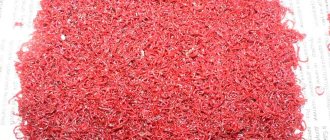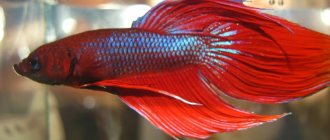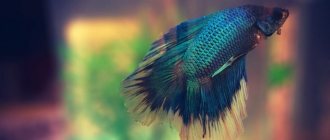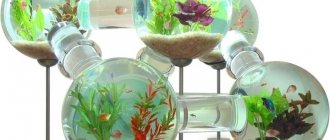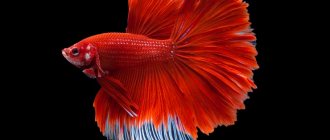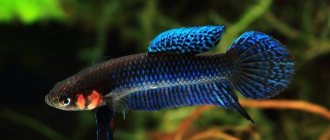- Disease Prevention
- Fin rot
- Ichthyophthiriasis (semolina)
- Treatment of fish with saline solution
- Exophthalmia (bulging eyes)
- Dropsy
- Oodiniosis: stuck together fins
- Columnaria
- Video - fish diseases (bettas)
Have you noticed in the pet store plastic containers with brightly colored fish with huge fins, gracefully swimming among algae and castles? This is the most beautiful species of fish called Betta splendens, also known as betta fish. Aquarists adore these fish, because they are easy to care for, but they are prone to various diseases.
Proper care, attentiveness, and compliance with a number of rules will help you avoid illnesses of your beloved pets and prolong life expectancy. Knowing what diseases a betta fish can develop and their signs, you can be calm about the health of your pet, which will delight you with its beauty and incredible grace for many years.
In this article, experts will tell you what diseases of betta fish exist and how to treat them. So, let's go.
Disease Prevention
These lovely fish suffer from bacterial and parasitic diseases. It’s easy to understand that your pet is sick: the fish hides at the bottom, refuses to eat, becomes covered with plaque and white spots, the color changes, and the fins are affected.
Let's figure out what causes diseases in betta fish:
- Poor water quality (fraught with decreased immunity and death of fish);
- Expired, low-quality food (immediately remove uneaten food);
- Garbage. Depending on the capacity of the aquarium, you need to regularly clean the aquarium once a week and change about 1/3 of the water;
- Insufficient filtration;
- An excess of pets in one container;
- Plants from other bodies of water;
- Impossibility of spawning (females get cancer, males become lethargic);
- Avitaminosis.
Important! Monitor the expiration dates of the food and do not overfeed the fish (you can find out the exact amount of food from the staff). An excess of food, as well as a lack of it, negatively affects the underwater beauties with sweeping fins.
Have you noticed the same symptoms in several fish? Check and change the water, install additional aeration, carry out the disinfection procedure. It’s worse if only one of the fish is sick: this indicates the onset of a bacterial disease, fraught with negative consequences. Let's figure out what diseases of aquarium betta fish occur and find out the main symptoms.
Cockfighting: You Didn't Know This
The betta is called a fighting fish for a reason. It's all about acutely expressed intraspecific aggression and territoriality. Two male bettas will not be able to live in one aquarium, even if its volume is over 300 liters. Ultimately, constant collisions will lead to the loss of fins and one of the rivals will die.
@cyin8003211 pixabay.com
The fish is popular in Thailand. There, among similar ones, they organized fights from which they made money. The tradition is still alive, but has become less popular and is preserved only in certain regions.
“Fighters” are specially prepared for tournaments using special tactics. To increase endurance, the fish is placed in a tall and narrow container, where it is forced to swim up and down because it does not have enough space. Also, with the help of enhanced aeration, strong whirlpools are created in round vessels - this is necessary for the development of strength. After this, he hones his skills on weaker, living opponents who are placed next to him.
What is most surprising about this spectacle is the nobility. The male will never attack the enemy if he swims upward for a portion of oxygen. If three males cross paths in one container at once, one of them will not participate. There will be a duel between the rivals, and then the observer will fight the winner.
@Icewall42 pixabay.com
This is how they make money from the blood of other creatures. Do you think this is acceptable? Leave your answers in the comments to our article.
Fin rot
The cause is the bacterium Pseudomonas, which got into the water along with food or new inhabitants. Usually it clings to young or weakened individuals, but if detected untimely, it can destroy the entire population of the aquarium.
The symptoms are:
- Lethargy.
- Sudden change in color.
- Ulcers or bluish plaque on the body.
- Cloudiness of the cornea.
- Blowing bubbles;
- Ugly, drooping, stuck together fins.
Have you noticed one or more signs of fin rot? Begin immediate treatment, and until complete recovery, quarantine the sick fish, otherwise it will infect other pets.
Most often, specialists treat betta fish with streptocide or another antibacterial agent. Thus, treating betta fish with metronidazole gives a quick effect and improved health.
In addition, you can use special products sold in pet stores.
In addition, treatment can be carried out with the following drugs:
- Bicillin-5 (penicillin substance with bactericidal action).
- Biomycin (general purpose antimicrobial antibiotic).
- Malachite green. Treatment is carried out for a maximum of five days (gradually increasing the dosage from 0.5 to 0.7 ml). Only freshly prepared solution is used, the processing process takes five hours.
- Violet K (chlorohydrite). The substance is diluted in proportions of 0.1 grams per liter. Having applied 15 ml of solution, add it to 15 liters of water and pour it into the aquarium.
Antibiotics are given for a couple of months (the norm is 20 grams per 100 liters).
Remember that illnesses in fish occur very quickly: sometimes the clock literally counts. If you doubt the correctness of the diagnosis, you should contact a veterinary clinic or the staff of the Underwater World pet store, who will suggest the ideal medications and help you choose the required dosage.
Character of cockerels
Bettas are popular aquarium fish from the Macropod family. The scientific name of the fish is Betta Splendens. Their character is not simple - fights between cockerels and other fish can often be observed in a shared aquarium, for which Betta was nicknamed “fighting”.
The homeland of cockerels is Thailand, where the fish live in small reservoirs with water temperatures from 21C to 27C. What is noteworthy is that the phenotype is at odds not only with other specimens, but also with representatives of its own genus. Fights can be brutal and furious, sometimes the fight ends in the death of one of the males. Females also know how to fight, but they are more lenient and friendlier to each other, so females are often kept 3-5 in one tank.
During competition with other fish, the color of the betta changes: the color saturation increases, and the fins and tail unfold, showing the Betta in all its glory. Aquarists, knowing about this feature of the phenotype, specially keep two males in one reservoir, divided into two compartments by a transparent wall. In Thailand, they even hold deliberately provoked fights between two individuals, gathering spectators and placing bets on victory. It should be noted that in such fights the cockerels do not die, but only end up with damaged fins.
Bettas fight not only with their relatives, but also with other phenotypes. The very name of the fish is reminiscent of the pugnacious nature of the birds of the same name. Despite their beauty and unpretentiousness, keeping bettas in a community aquarium can be difficult for aquarists, especially beginners.
Despite the fact that Betta does not get along well with other residents, this does not mean that the fish should live its entire life alone. The correct selection of neighbors in the aquarium, space, grottoes and dense flora will help create a small underwater world where all the inhabitants will coexist peacefully. To organize such harmony, you should first of all know the general rules of keeping and the compatibility of bettas with other fish.
Ichthyophthiriasis (semolina)
Have you noticed nodules or white bubbles on the body of the fish, reminiscent of lumps of semolina? Your pet is unhappy with the temperature of the water or the dirt, so she has contracted an infection caused by the ciliate ichthyophthirius. The signals are:
- Lack of appetite.
- Slow breathing;
- Impaired coordination of movements.
- Decreased activity.
- Weight loss.
In addition to bicillin-5 and trypaflavin, it is worth treating your betta fish in a salt bath.
Attention! Don’t think that just adding table salt will make the bacteria disappear. The recommended proportions must be carefully observed: non-compliance with the technology and excessive saturation of the solution lead to the death of the cockerel.
Posts 1 page 10 of 21
Share12011-02-10 18:51:53
- Author: fish23
- Yours on the forum
- Registered: 2011-02-10
- Invitations: 0
- Posts: 10
- Respect: [+0/-0]
- Positive: [+3/-0]
- Time spent on the forum: 3 hours 27 minutes
- Last visit: 2011-02-24 22:28:19
Hello! I really need help, there is a problem with the cockerel. 1) Aquarium volume - 7 l 2) There is a lid, lighting 3) Aeration - no, filter - no 4) Plants: 2 anubias 5) The soil is shallow, the layer is 3 cm 6) I change the water in the aquarium every week 1/3 7) Food - dry flakes, chips, tablets water temperature - 26-28 Initially, there was one cockerel and 2 gourami in the aquarium, which he constantly mercilessly chased, then the gouramis were put in a large aqua, 2 chickens were bought for the cockerel, although there is an opinion that in fact at least 1 of them is a male: at first the rooster chased them, but 2 weeks ago there was a riot and these two “females” fought him as best they could, after which they were put in a jar and live happily there. At first the rooster also lived normally, then a greasy film began to appear on the surface of the water and began to spit out food. Over the course of a week, I changed the water several times, washed the soil and walls, now there is no film, but the cockerel has completely refused food. He doesn't seem to notice him. He hasn’t eaten for 4 days, and he didn’t eat very well the previous days either! What to do?? He has also become inactive and is constantly near the surface of the water.
I really need help, there is a problem with the cockerel. 1) Aquarium volume - 7 l 2) There is a lid, lighting 3) Aeration - no, filter - no 4) Plants: 2 anubias 5) The soil is shallow, the layer is 3 cm 6) I change the water in the aquarium every week 1/3 7) Food - dry flakes, chips, tablets water temperature - 26-28 Initially, there was one cockerel and 2 gourami in the aquarium, which he constantly mercilessly chased, then the gouramis were put in a large aqua, 2 chickens were bought for the cockerel, although there is an opinion that in fact at least 1 of them is a male: at first the rooster chased them, but 2 weeks ago there was a riot and these two “females” fought him as best they could, after which they were put in a jar and live happily there. At first the rooster also lived normally, then a greasy film began to appear on the surface of the water and began to spit out food. Over the course of a week, I changed the water several times, washed the soil and walls, now there is no film, but the cockerel has completely refused food. He doesn't seem to notice him. He hasn’t eaten for 4 days, and he didn’t eat very well the previous days either! What to do?? He has also become inactive and is constantly near the surface of the water.
Edited by fish23 (2011-02-15 00:12:28)
Treatment of fish with saline solution
Treatment is carried out as follows:
- We transplant the cockerels into a separate container.
- Take pure salt and dissolve it in warm water (2 tablespoons of sodium chloride per 10 dm3).
- Turn on the aerator for 20 minutes.
- We launch the fish (if they lie sideways, you need to dilute the mixture).
Often this medicine for betta fish is enough to cure any infectious diseases.
It is important that there will be no benefit from one time: such treatment should be carried out in courses over a period of two weeks to a month. In a favorable situation, treatment of betta fish with chloramphenicol brings instant results.
History of appearance
Beta is the oldest freshwater species kept in captivity after the Goldfish. Aggressive fish were discovered in the 19th century. in Siam and in reservoirs in southeast Asia. Enterprising aquarists, crossing wild cockerels, got “biting fish”, which they called Pla Kat. Betta splendens has been named since 1909.
Appearance
Betta fish are labyrinthine fish with an oval, laterally flattened, and elongated body. The length is 4-6 cm, sometimes a betta fish of 10 cm is found. The tail of the cockerel, similar to a lush veil, and the upper fins are rounded, and on the chest they are pointed. The line of the lower fin runs along the entire abdomen.
The color of the rooster fish is varied: some are completely one color, others are two-colored, and others are multi-colored, like a rainbow.
Where do they live in nature?
The betta fish chooses warm and shallow fresh water bodies for its habitat, even puddles, often muddy and polluted, muddy rivers where the current is slow. Betta fish are found in rice fields flooded with water without oxygen, and sometimes even inhabit drains. The cockerel is a fish that has adapted to breathe air from the atmosphere with the help of a labyrinth - a special organ. The cockerels were born in the reservoirs of Southeast Asia.
Fish fights
Male betta fish do not tolerate rivals in a small territory, and start fights when the loser must die. When attacking, the cockerels open their mouths wide and sink their sharp, thin teeth deeply into the body of their fellow. The winner does not allow the defeated fish to take a breath of fresh air and it dies.
Exophthalmia (bulging eyes)
If you notice a change such as bulging eyes in betta fish, it is a viral infection that is treated with Epsom salt (magnesium sulfate) and Ammonia-minus treatment.
The surface of the eye becomes cloudy, wrapped in a white film, the eyes can pop out of their sockets: in the most severe case, the cockerel will lose its organs of vision and die.
If you notice that the cockerel fish has become sad and its eyes have become white, take action (a favorable outcome depends on the timely detection of the disease). Replace the water, reduce food intake - if the source is improper conditions, then the swelling of the eyes will go away quickly.
These measures did not help, other infected people began to appear with a gray coating on their bodies and difficulty breathing? Place them in a plastic container, use ointments and antibiotics.
Origin and distribution
Crowntails come from sunny Thailand, which was once called Siam (hence the name of the species - Siamese cockerels), where they lived in puddles of rice plantations and shallow ditches. In their appearance, modern bettas differ from their wild ancestors, which is explained by careful breeding to improve characteristics, fin color, size, etc. The first such cockerel was bred using a selective method in 1996, by the Indonesian beta breeder Ahmad Yusuf.
Males differ from females not only in
larger in size, but also long beautiful fins on the belly, back and tail.
Dropsy
If you notice that your betta fish has a swollen belly, treatment will be effective only at the very beginning of the disease. Dropsy is a very serious disease. There can be many reasons for the occurrence, it is important to find the source in time and promptly seek diagnostics from specialists. You can independently determine it by the following signs:
- Enlarged belly.
- Red spots at the base of the fins.
- Refusal to eat.
- Bruises on the body.
- Swollen eyes.
- Fast weight loss.
Important! In most cases, the source is a bacterial infection contracted while digging in the ground. Pay attention to the ammonia content in the water and inappropriate diet: as a result of unscrupulous care, the pet may die. If you notice a symptom such as constipation in your betta fish, treatment should be started immediately!
Keep in mind that in such a situation, complete disinfection and replacement of decorative elements, plants and other attributes are necessary.
Why does the fish stop swimming and lie to the bottom?
There are many reasons why a fish may remain on the bottom for a long time. Do not begin to take action until you clearly understand the situation. Here are a few reasons why your betta may stop behaving normally:
- stress;
- various diseases;
- natural behavior.
For newly purchased fish, stress inevitably arises, because it is not yet accustomed to new conditions. Cockerels are sensitive to all factors; even changing water hardness can affect their behavior. Temperature is also extremely important: if it is below 19 degrees, the fish will remain at the bottom in a comatose state.
Oodiniosis: stuck together fins
With “velveteen disease,” the main manifestation is the presence of a light yellow coating on the body. There are other characteristic features:
- Breaking and splitting scales.
- Loss of color brightness.
- Apathy.
- Labored breathing.
- Drooping fins.
Appears as a result of poor care, hypothermia, or the introduction of individuals who have not undergone quarantine.
Antibacterial agents are used for treatment:
- Antipar (an antiseptic that affects fungus).
- Seraoodinopur (water condenser).
- Formamed (a drug against invasive diseases and maintaining a healthy environment).
- Ichthyofo (a substance based on two septic tanks: formalin and malachite green).
Please note: if at least one individual is unwell, it is necessary to carry out complete disinfection and treatment of the rest. Otherwise, the underwater beauties will infect each other, and the disease will drag on indefinitely.
During quarantine, maintain an elevated water temperature.
External description
This species probably attracted your attention in pet stores, because their main difference is their bright color, which can have all the colors of the rainbow and expressive veil-shaped fins.
Each color has its own interesting name: Mustard Gas, Lemon Meringue, Pharoah, Super black/super red, Thai Flag and many others. Males are brighter in color than females. The size of the fin will also help to distinguish a boy from a girl: in boys it is much more luxurious and voluminous, in girls it is more miniature. The fish are small in size and in captivity grow no more than 7-8 cm in length.
Columnaria
If the cockerel is swollen near the gills, most likely there is an “oral fungus” that appears due to overcrowding, high concentration of organic matter, and untimely feeding.
The disease can be detected by the following signs:
- Lethargy.
- The desire to hide in a secluded place.
- Dark coating on the gills.
- Mouth damage.
- The appearance of cloudy fluid in the eyes.
Treatment of fungus in betta fish begins with the use of complex remedies, the use of disinfectants, and baths with phenoxyethane. Some people suggest adding methylene blue or Merbromin to promote faster healing.
Have you noticed that one or more pets are not feeling well? Now you know what diseases a cockerel can catch, and you can easily select the appropriate medications.
Unable to diagnose the disease? There are many photos on the Internet that help you establish and select effective treatment during consultation with specialists.
Feeding the fish
The fish are fed 1-2 times a day. Overfeeding threatens obesity and can even lead to death. It is recommended to give fish food in the amount of 5% of their body weight. The daily diet of bettas may include:
- dry flakes;
- granular feed;
- live food (worms, tubifex, bloodworms, crustaceans), which is also acceptable in dry or frozen form.
Do not mix different types of food in one feeding. If you decide to switch your fish to a different type of food, then introduce it gradually, increasing the percentage of the new product per serving.
After birth, babies need to be fed more often, but in small quantities. It is strictly forbidden to use dry food for adult fish when feeding. It is necessary to start feeding with plankton, gradually transferring the Artemia larvae to a standard diet.
When purchasing food, pay attention to the shelf life. At home, keep them closed and away from moisture.
